Scientists analyzing the night sky and looking at galaxies have attempted over the years to explain why galaxies form in various shapes and sizes, but have been unable to do so despite their best attempts. However, it would appear that, recently, a team has managed a breakthrough, when experts at the Embry-Riddle University in Arizona have devised a surprisingly accurate model of the Universe. The simulation includes most of today's galaxies, and, oddly enough, most of them have their current shapes, Space reports.
This has never before been achieved in a computer simulation that sought to recreate the entire history of the Cosmos, such as the fact that it started more than 13.7 billion years ago. “We were completely astonished that our model predicted both the abundance and diversity of galaxy types so precisely,” ERU researcher Nick Devereux, who has been a member of the team that has performed the new study, explains. What the team has done differently than other groups that attempted the same thing before it has been to introduce dark matter models into its simulations.
The researchers essentially predicted that one of the most influential factors in establishing a galaxy's shape and size was the distribution of dark matter around the space structure. At this point, there are two main types of galaxies in the Universe – elliptical and spiral. Elliptical galaxies are like a barrel of stars, tightly grouped together, whereas spiral galaxies (such as the Milky Way and Andromeda) have two or more arms spiraling from their central regions. Spiral galaxies are further divided into two groups, barred and unbarred. Barred spiral galaxies have a central bar of stars, out of which the arms stretch out.
The new supercomputer model that the team has developed includes massive amounts of observational data, as well as the “Lambda Cold Dark Matter” theory of the Universe. This idea states that most of the Cosmos, about 72 percent, is made up of dark energy, whereas 23 percent is accounted for with dark matter. The remaining five percent includes everything we can see in the Universe, that is stars and galaxies, black holes, pulsars, quasars, blazers, neutron stars, space rocks, exoplanets, and so on. When the supercomputer program finished running, the researchers were surprised to find out that the simulation predicted almost the exact number of each type of galaxy in the known Universe.
“It really boosts my confidence in the model,” astronomer and study researcher Andrew Benson, who is based at the California Institute of Technology (Caltech), says. “These new findings set a clear direction for future research. Our goal now is to compare the model predictions with observations of more distant galaxies seen in images obtained with the Hubble [Space Telescope] and those of the soon-to-be-launched James Webb Space Telescope,” Devereux reveals. Details of the new model were showcased in the latest issue of the respected scientific journal Monthly Notices of the Royal Astronomical Society.

 14 DAY TRIAL //
14 DAY TRIAL //